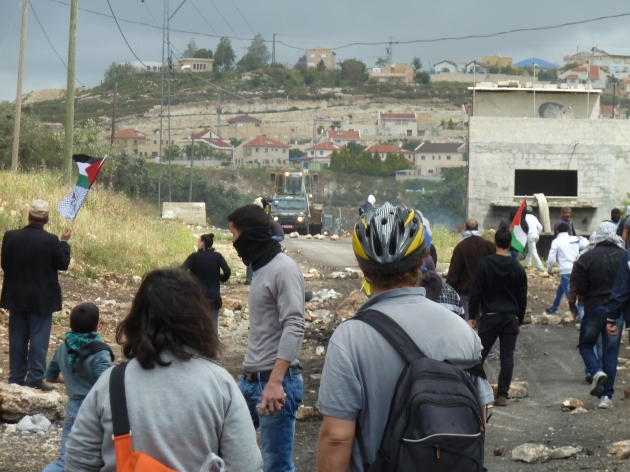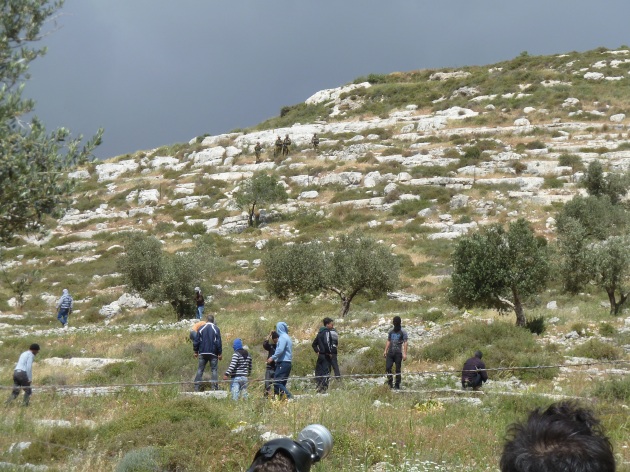It’s Friday, the day for prayers and protest, and we are in the village of Kufr Qadum. It’s story is similar to many West Bank villages; the nearby settlement of Qedumim was established around 35 years ago and since then much of the village’s land has been confiscated. Villagers are also banned from using the road that goes directly to the nearest Palestinian city of Nablus, as it cuts through the settlement, and must now take a long detour around the settlement to reach either Nablus or the nearest Palestinian village.
The village has been protesting since 2011. Every Friday demonstrators march towards the forbidden road. Since then many demonstrators have been injured, and one protester was attacked by military dogs. The army regularly raids the village at night, sometimes breaking in to people’s homes and damaging property, and many villagers have been imprisoned.
The majority of today’s demonstrators are villagers (all men, as Palestinian women are rarely seen at demonstrations) along with several members of IWPS, ISM and some Israeli activists. The Israelis are from Anarchists Against the Wall, a group who once turned up at the US embassy with a box of spent tear gas grenades (Israeli weapons are paid for by American tax dollars) with a note saying ‘return to sender.’
The ritual begins in late morning when a truck arrives with a load of used tyres which are piled across the main road out of the village towards the settlement. The protesters set fire to the pile, sending huge clouds of black smoke in the direction of the settlement. Today the wind favours the protesters; it’s all blowing away from the village and towards the settlers.
- The main road out of Kufr Qadum, with the settlement of Qedumim in the background.
After midday prayers the march begins towards the settlement. An Israeli army jeep is visible through the clouds of smoke. The protesters have anticipated the jeep, and have set up a series of makeshift blockades of rocks at intervals down the road. The army has anticipated the blockades, and are accompanied by a bulldozer.
There are soldiers up on the hillside overlooking the village and some of the youth throw stones at them. In a familiar routine, the army responds by shooting tear gas at the protesters. Some of the older villagers stand further down the hillside shouting directions at the youths; at first they shout at the youth to hit the soldiers, later, when the situation begins to look more risky, to come back.
One of the Israeli protesters pointed out a mysterious individual at the top of the hill, away from the other soldiers, dressed in black. He said that the last time he appeared, there were arrests of internationals, and he advises us to take a different route home. I ask him if he thinks the presence of internationals bothers the army. He says that in their worldview, if there are Israelis and internationals present at a demonstration, then they must be telling the Palestinians what to do, so part of their strategy is to get internationals and Israelis out of the picture.
I’m never sure what I feel about this style of protest, which despite the stone-throwing, is part of what is considered non-violent resistance. Many people have observed that these weekly demonstrations, which take place in villages every Friday across the West Bank, are like a ritual or a game in which each side participates week in week out, with nothing gained. When I spoke to Ahmed, the coordinator, he told me that the demonstrators have three main objectives: to reopen the main road, now closed for 11 years, prevent the expansion of the settlement, and for the village’s land to be returned. But when I asked him if they would be prepared to march all the way to the settlement, if ever the army decided to take the day off, he gave an emphatic no.
This is a small group of people protesting against a heavily armed occupying force; a very different context than political protest in Western democracies, where the leadership is accountable to the people, or even Cairo, where it’s possible for millions to protest en masse. The difficulty for Palestinians is always that they have so few options – they have no standing army, no real political representation, and no powerful friends. For now, this is how many Palestinians choose to resist the occupation.
Once the organisers declare the protest over, we sit and drink tea. We have been advised to wait a while in case there is a checkpoint set up on the way to catch activists. The Israelis leave ahead of us, then call to say the way ahead is clear. We say goodbye to our hosts and leave.



